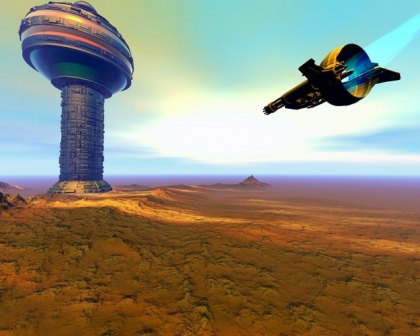Musk builds argument for a red planet city

It’s not just that Musk can envision the apparatus needed to make humans an “multi-planetary species.” He details what it would take to establish a self-sustaining settlement in an article published in this month's edition of the journal New Space. This is how he sees it:
The cost: First and foremost, the cost of relocating to Mars will have to become more affordable. “Taking an Apollo-style approach, an optimistic cost would be about $10 billion per person,” he writes. No one could afford it. “If we can get the cost of moving to Mars to be roughly equivalent to a median house price in the United States, which is around $200,000, then I think the probability of establishing a self-sustaining civilization is very high. I think it would almost certainly occur.”
Pizza on the red planet: Mars will have the comforts of home. The ship, he explains, “needs to fit 100 people or thereabouts in the pressurized section, carry the luggage and all of the unpressurized cargo to build propellant plants, and to build everything from iron foundries to pizza joints to you name it—we need to carry a lot of cargo.”
The long trip: Depending on the position of Mars, the trip could take as few as 80 days. Over time, that would improve, he predicts, and the trip could take only 30 days. And if the idea of a monthlong space trip still seems daunting, he puts it in perspective. “It is fairly manageable, considering the trips that people used to do in the old days where sailing voyages would take six months or more.”
Fun in space: Not many would volunteer to be sandwiched in a little can and blasted into space. So Musk envisions a luxurious spaceship. “It cannot feel cramped or boring. Therefore, the crew compartment or the occupant compartment is set up so that you can do zero-gravity games—you can float around. There will be movies, lecture halls, cabins and a restaurant. It will be really fun to go. You are going to have a great time!”
The logistics: Mars actually has the chemistry needed for propellant. But beyond Mars, there could be propellant stations on various moons that would allow humans to travel anywhere in the solar system. “By establishing a propellant depot, say on Enceladus (one of Saturn's moons) or Europa (one of Jupiter's moon), and then establishing another one on Titan, Saturn's moon, and then perhaps another one further out on Pluto or elsewhere in the solar system, this system really gives you the freedom to go anywhere you want in the greater solar system.”
Related:
Mars colonization project gets funding
Obama envisions extended stays on Mars
Follow StudyHall.Rocks on Twitter.
If you would like to comment, give us a shout, or like us on Facebook and tell us what you think.

